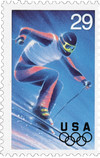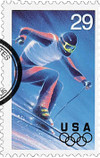
# 2807 - 1994 29c Winter Olympics: Alpine Skiing
U.S. #2807
1994 29¢ Alpine Skiing
Winter Olympics
· The1994 Winter Olympics stamps were voted the second most popular of 1994
· Placed ninth in the USPS’s All-Time Top 10 Most Popular Commemorative Stamps List
Stamp Category: Commemorative
Set: 1994 Winter Olympics
Value: 29¢
First Day of Issue: January 6, 1994
First Day City: Salt Lake City, Utah
Quantity Issued: 38,800,000
Printed by: Ashton-Potter
Printing Method: Lithographed
Format: Panes of 20 in sheets of 120; offset printing plates of 240
Perforations: 11.2
Microprinting: “1994” and “WINTERSPORTS” in black microprinting for increased security.
Why the stamp was issued: To commemorate the 1994 Winter Olympics in Lillehammer, Norway, which ran from February 12-27, 1994.
About the stamp design: These 1994 Winter Olympics stamps featured artwork by Lon Busch, who had previously designed the 1992 Winter Olympics stamps (US #2611-15). Busch’s airbrushed images have a glow to them, meant to imply the athletes had a bright light shining on them. Also, each stamp features the color of one of the Olympic rings – the Alpine skier is blue, the luge is yellow, the ice dancing is black, the Nordic skier is green, and the ice hockey is red.
Busch created his stamp designs from photographs and the Alpine skiing image was accepted with few changes required. It pictures a slalom skier wearing a helmet and goggles.
Special design details: “WINTERSPORTS” is microprinted in a small dark line behind the skier’s right foot and “1994” is microprinted on the side of ski under his left foot.
First Day City: Salt Lake City, Utah – America’s proposed city to host the 2002 Winter Olympics.
Unusual fact about this stamp: These 1994 Winter Olympics stamps have been found with two sizes of perforation holes, though the gauge is the same – 11.2 holes per two centimeters. While Ashton Potter found no issues with their equipment, the USPS offered two potential causes for the variations. One could be wear on the perforation pins, and the other could be differences in pressure when stacks of stamp sheets were perforated at the same time.
About the 1994 Winter Olympics Stamps: The 1994 Winter Olympics stamps continued a long-standing USPS tradition of issuing stamps to honor the international sporting event. The US issued its first Olympic stamps in 1932 honoring the Winter Games in Lake Placid, New York and the Summer Games in Los Angeles, California. They didn’t issue Olympic stamps again until 1960, when the Games returned to the US. Since 1972, the USPS has issued stamps for every Olympic Games, regardless of where they’re held.
History the stamp represents: The 1994 Winter Olympics were applauded for the beautiful landscape and venues as well as the enthusiastic fans. In all, 1,737 athletes participated (1,215 men and 522 women) in 61 events in six sports. These were the first Winter Games to not be held the same year as the Summer Games, due a change that placed them two years apart. Norway won the most medals (26) but Russia had the most gold (11).
Alpine Skiing
A breathtaking sport, downhill or Alpine skiing is a test of speed and skill as competitors race over a course at up to 65 miles per hour. An Olympic event since 1936, Alpine skiing consists of five different contests: downhill, slalom, giant slalom, super giant slalom, and the combined.
A test of high-speed skiing, the downhill is run on a course, that for men drops 800 to 1,000 meters. A skilled downhill racer can complete the course in 1 1/2 to 2 minutes. The slalom challenges the skier’s skill in high-speed turns. A series of numbered gates are set up so that the racers must make many turns, skiing in a zig-zag fashion.
Combining the elements of the downhill and the slalom, the giant slalom requires both speed and the ability to make high-speed turns. The super giant slalom is a cross between the downhill and the giant slalom. And the combined competition consists of a downhill race and a slalom. Although the two events are always held at the same location, they often take place on different days.
Women also compete in these events, although at shorter distances and on courses with less of a vertical drop.
U.S. #2807
1994 29¢ Alpine Skiing
Winter Olympics
· The1994 Winter Olympics stamps were voted the second most popular of 1994
· Placed ninth in the USPS’s All-Time Top 10 Most Popular Commemorative Stamps List
Stamp Category: Commemorative
Set: 1994 Winter Olympics
Value: 29¢
First Day of Issue: January 6, 1994
First Day City: Salt Lake City, Utah
Quantity Issued: 38,800,000
Printed by: Ashton-Potter
Printing Method: Lithographed
Format: Panes of 20 in sheets of 120; offset printing plates of 240
Perforations: 11.2
Microprinting: “1994” and “WINTERSPORTS” in black microprinting for increased security.
Why the stamp was issued: To commemorate the 1994 Winter Olympics in Lillehammer, Norway, which ran from February 12-27, 1994.
About the stamp design: These 1994 Winter Olympics stamps featured artwork by Lon Busch, who had previously designed the 1992 Winter Olympics stamps (US #2611-15). Busch’s airbrushed images have a glow to them, meant to imply the athletes had a bright light shining on them. Also, each stamp features the color of one of the Olympic rings – the Alpine skier is blue, the luge is yellow, the ice dancing is black, the Nordic skier is green, and the ice hockey is red.
Busch created his stamp designs from photographs and the Alpine skiing image was accepted with few changes required. It pictures a slalom skier wearing a helmet and goggles.
Special design details: “WINTERSPORTS” is microprinted in a small dark line behind the skier’s right foot and “1994” is microprinted on the side of ski under his left foot.
First Day City: Salt Lake City, Utah – America’s proposed city to host the 2002 Winter Olympics.
Unusual fact about this stamp: These 1994 Winter Olympics stamps have been found with two sizes of perforation holes, though the gauge is the same – 11.2 holes per two centimeters. While Ashton Potter found no issues with their equipment, the USPS offered two potential causes for the variations. One could be wear on the perforation pins, and the other could be differences in pressure when stacks of stamp sheets were perforated at the same time.
About the 1994 Winter Olympics Stamps: The 1994 Winter Olympics stamps continued a long-standing USPS tradition of issuing stamps to honor the international sporting event. The US issued its first Olympic stamps in 1932 honoring the Winter Games in Lake Placid, New York and the Summer Games in Los Angeles, California. They didn’t issue Olympic stamps again until 1960, when the Games returned to the US. Since 1972, the USPS has issued stamps for every Olympic Games, regardless of where they’re held.
History the stamp represents: The 1994 Winter Olympics were applauded for the beautiful landscape and venues as well as the enthusiastic fans. In all, 1,737 athletes participated (1,215 men and 522 women) in 61 events in six sports. These were the first Winter Games to not be held the same year as the Summer Games, due a change that placed them two years apart. Norway won the most medals (26) but Russia had the most gold (11).
Alpine Skiing
A breathtaking sport, downhill or Alpine skiing is a test of speed and skill as competitors race over a course at up to 65 miles per hour. An Olympic event since 1936, Alpine skiing consists of five different contests: downhill, slalom, giant slalom, super giant slalom, and the combined.
A test of high-speed skiing, the downhill is run on a course, that for men drops 800 to 1,000 meters. A skilled downhill racer can complete the course in 1 1/2 to 2 minutes. The slalom challenges the skier’s skill in high-speed turns. A series of numbered gates are set up so that the racers must make many turns, skiing in a zig-zag fashion.
Combining the elements of the downhill and the slalom, the giant slalom requires both speed and the ability to make high-speed turns. The super giant slalom is a cross between the downhill and the giant slalom. And the combined competition consists of a downhill race and a slalom. Although the two events are always held at the same location, they often take place on different days.
Women also compete in these events, although at shorter distances and on courses with less of a vertical drop.












